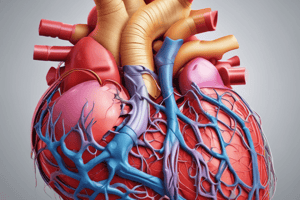Podcast
Questions and Answers
Which of the following is true regarding the left atrium?
Which of the following is true regarding the left atrium?
- The mitral valve is a tricuspid valve
- Its wall contains pectinate muscles throughout.
- It receives deoxygenated blood from the lungs via the four pulmonary veins.
- The four openings of the pulmonary veins are located in the lower right and left atrium. (correct)
What is the function of the mitral valve in the heart?
What is the function of the mitral valve in the heart?
- It regulates the flow of blood from the left ventricle to the aorta
- It regulates the flow of blood from the right atrium to the right ventricle
- It regulates the flow of blood from the left atrium to the left ventricle (correct)
- It regulates the flow of blood from the right ventricle to the pulmonary artery
Which of the following statements about the pulmonary veins is true?
Which of the following statements about the pulmonary veins is true?
- The four openings of the pulmonary veins are upper right and left, and lower right and left. (correct)
- There are three openings of the pulmonary veins.
- The mitral valve is located in the pulmonary veins.
- The wall of the pulmonary veins contains pectinate muscles.
What is the function of the papillary muscles in the left ventricle?
What is the function of the papillary muscles in the left ventricle?
What is the difference in thickness between the walls of the left ventricle and the right ventricle?
What is the difference in thickness between the walls of the left ventricle and the right ventricle?
What is the function of the Trabeculae Carnae in the ventricular wall?
What is the function of the Trabeculae Carnae in the ventricular wall?
What is the function of the chorda tendinae in the heart?
What is the function of the chorda tendinae in the heart?
Where is the bicuspid valve located?
Where is the bicuspid valve located?
What is the main difference between the inflow and outflow tracts of the left ventricle?
What is the main difference between the inflow and outflow tracts of the left ventricle?
Flashcards are hidden until you start studying
Study Notes
- The left atrium receives oxygenated blood from the lungs via four pulmonary veins.
- The wall of the left atrium is smooth and does not contain pectinate muscles except at the auricle.
- The left atrium has four openings: upper right and left and lower right and left pulmonary veins.
- The left atrium has a bicuspid valve called the mitral valve that allows passage of oxygenated blood to the left ventricle.
- The wall of the left ventricle is three times thicker than the wall of the right ventricle.
- The cavity of the left ventricle is formed of an inflow tract and outflow tract.
- Blood enters the left ventricle from the left atrium through the mitral valve (bicuspid valve).
- The left ventricle has trabeculae carne, papillary muscles (anterior and posterior), and chorda tendinae.
- Trabeculae carne are ridges of the myocardium in the ventricular wall that are finer and more numerous.
- Chorda tendinae are fine strands that control the closure of the valve during contraction of the ventricle.
Studying That Suits You
Use AI to generate personalized quizzes and flashcards to suit your learning preferences.




